CHEMISTRY CHAPTER ZERO
Making Foam Atoms and Laboratory Bags
In order to push the students to ask the relevant questions – about the weight and bonding properties of the foam atoms – the atoms should be as nearly identical as possible in all other characteristics: size, color, feel upon squeezing, and arrangement of the velcoins and glue. In this manner irrelevant clues are suppressed. There must be lots of ways to make atoms that will work to teach the concept of atoms, bonding, and the periodic table. This is the way that I have developed. It works, and it results in atoms that cost about $0.10 each -- $0.08 of that is the steel core. I have assumed that – at some point -- students with throw the foam atoms at each other, hence the foam rather than some hard material. I have also assumed that some student will swallow one of the atoms [Don’t laugh!], and hence the heavy atom core is steel rather than readily available lead shot, which could be toxic if swallowed. |
|
Materials/Equipment Required 5/8” foam backer rod |
|
INSTRUCTIONS |
|
1. To make 100 atoms you will need just over 6 feet of backer rod. Decide now how many light and how many heavy atoms you intend to make. 50/50 is a pretty good choice. Also decide how many loop and how many hook velcoins you intend to use. A 50/50 choice is typical. These choices result in 25 of each the four types of foam atoms. |
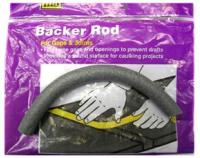 |
2. The backer rod must be cut to ¾” segments. It is important that each segment be as close to ¾” as possible, with flat ends. |
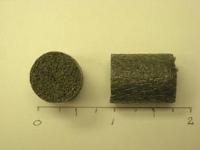 |
You will need to make a jig block, which has a 5/8” and a 5/16” hole drilled in a piece of scrap 2” x 4” wood, and a saw cut that crosses the holes ¾” from one side. You can use a small sharp knife inserted into the saw cut to make clean cuts of the backer rod. Cut will little pressure. Cut the backer rod into ¾” segments at this time. |
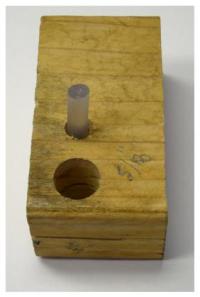 |
3. Plug in the glue gun and let it come to temperature. |
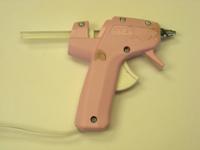 |
4. Now use the glue gun to melt a conical hole from each end of the foam segment. Do not squeeze the glue gun trigger. |
 |
5. Now ready the cores. You will have to cut glue sticks into ¾” segments to make the light atom cores. |
 |
| 6. The picture at the right shows the cores partially inserted, and the picture below shows them fully inserted. |
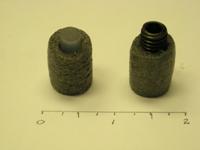 |
The fit for the steel core is typically tight, and it may help to use the socket key to screw the steel core into the foam segment |
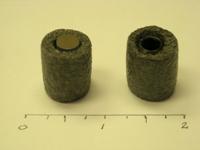 |
7. The picture shows the bag for the inexpensive glue sticks used. |
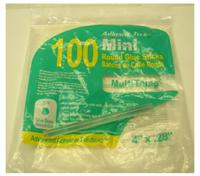 |
8. Now deposit a blob of glue on the one end of each atom. |
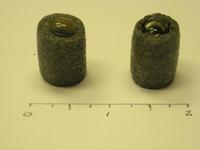 |
| Before the glue hardens put the appropriate velcoin on top of the glue. |
 |
Take care to align the velcoin with the backer rod cylinder. |
 |
9. Wait a bit for the glue to cool and harden. Then turn the atoms over and use the glue gun to deposit a somewhat larger blob of glue on the other end of the atoms. Do not put a velcoin on this end. |
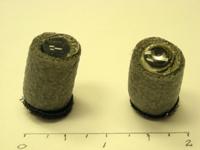 |
10. The laboratory bags are made from opaque 30 gallon garbage bags. Cut the bag at its half-height point, and then, for each these two parts. Slit seams to make two long pieces, each of which is then cut into roughly equal halves. For each of these four pieces, use masking tape to join two edges to make a cylinder with open ends. Bind each end with a rubber band -- just tight enough to hold on a wrist. |
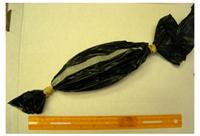 |
| 11. For students just beginning to work with the foam atoms and laboratory bags, put six atoms in each bag, including one each of the four types of atoms. Make sure to make at least one hook-loop bond, so that the students have to encounter atoms and molecules. |
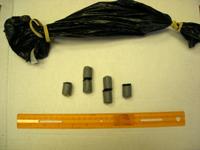 |
Suppliers (I have no financial interest in any of the suppliers mentioned.) Backer rod – any hardware store. I got mine at Home Depot. Be sure to get 5/8” diameter Glue gun (high heat) and glue sticks (0.28” diameter, multi-heat). Any crafts store. I got mine at Walmart. Jig block – home made Socket set screws [3/8” x 16 x ¾”, cup head]. Look in the local Yellow Pages for suppliers of screws and bolts. Typically they are sold in lots of at least 100. The supplier can also sell you a socket key. Velcoins – If you buy from a fabric store, you will pay about $0.10 per velcoin. If you buy in bulk, you can buy 1000 (of a particular type) for about $12.00, i.e., $0.012 per velcoin. Try http://feinersupply.com. If you are in a bind, contact Lynn Melton. Trash bags, rubber bands, and masking tape – grocery store, Home Depot, etc. |
|
Download a pdf file of this page
Enough, enough!
Show me how you can help me learn chemistry!